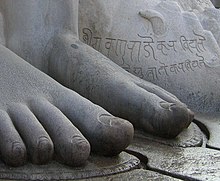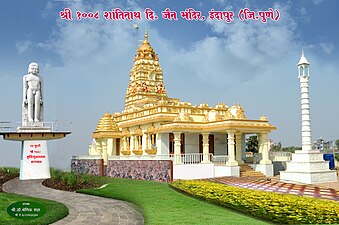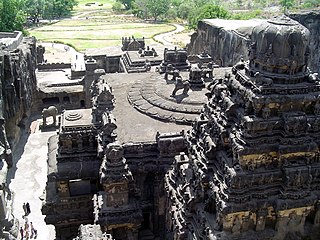
Aurangabad district, officially known as Chhatrapati Sambhaji Nagar district, is one of the 36 districts of the state of Maharashtra in western India. It borders the districts of Nashik to the west, Jalgaon to the north, Jalna to the east, and Ahmednagar to the south. The city of Aurangabad houses the district's administrative headquarters. The district has an area of 10,100 km2, of which 37.55% is urban and the rest is rural. Aurangabad District is a major tourism region in Marathwada.

Kumbhoj is the name of an ancient town located in Kolhapur district in Maharashtra. The town is about eight kilometers from Hatkanangale, about twenty seven kilometers from Kolhapur and currently, also is the Taluka or Tehsil Headquarters. The famous Jain Tirtha known as Bahubali, is just two kilometers away from the Kumbhoj city.

Mumbai has one of the largest populations of Jains among all the cities in India. Mumbai also has numerous Jain temples. One of the best known is the Babu Amichand Panalal Adishwarji Jain Temple, Walkeshwar.

Rajasthan, a state in western India, has had a close historical connection with Jainism. Southwestern Rajasthan was the main centre for Svetambara Jainism. Major Digambara centres are in the northern and eastern parts of Rajasthan. Central and Northern Rajasthan are the main centres for the Terapanth sect of Svetambara Jainism.

Jainism has had a notable following in Gujarat. According to the 2011 Census of India, around 0.959% of the population of Gujarat is Jain. There are several old Jain temples that draw pilgrims from Jains around the world in places such as Palitana, Taranga, Sankheshwar, Idar.

Mangi-Tungi is a prominent twin-pinnacled peak with plateau in between, located near Tahrabad about 125 km from Nashik, Maharashtra, India. Mangi, 4,343 ft (1,324 m) high above sea level, is the western pinnacle and Tungi, 4,366 ft (1,331 m) high, the eastern. Mangi-Tungi is 30 km (19 mi) from the city of Satana.
Indapur is a town and a municipal council in Pune district in the Indian state of Maharashtra. Indapur is known for Jahagir of Chhatrapati Shivaji Maharaj's father and grandfather. Chhatrapati Shivaji Maharaj's grandfather Malojiraje died in battle in Indapur.
Jintur city and a municipal council in Parbhani district in the Indian state of Maharashtra.
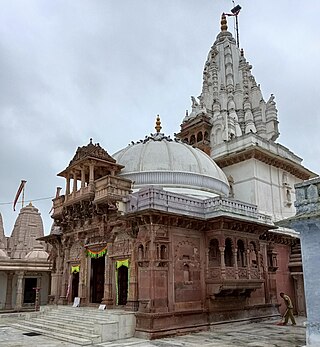
Maksi is a city and a municipality in Shajapur district in the Indian state of Madhya Pradesh. It is famous for Jain Temple of Maksi Parshwanathh Ji. Maksi has an ever buzzing market which is famous for sweet samosas.
Parola is a city and a municipal council in Jalgaon district in the Indian state of Maharashtra. It is located on the Hajira (Surat)–Dhule–Kolkata national highway 6. The municipal council was established by the British government before the independence of India. This City is centuries old known for the two main features such as the Shree Balaji Temple and The Parola fort Also known as the native of Rani Laxmibai of Jhansi.

Maharashtra attracts tourists from other Indian states and foreign countries. It was the second most visited Indian state by foreigners and fifth most visited state by domestic tourists in the country in 2021. Aurangabad is the tourism capital of Maharashtra.
Takali Dhokeshwar is a village in Ahmednagar District, Maharashtra, India. It is located at the intersection of the Mumbai - Vishakhapattanam highway and the Satara - Nashik road.

The Shantinath Jain Teerth, also known as Shri 1008 Shantinath Digambar Jain Mandir, is a Jain temple located in Indapur, Pune, Maharashtra. The design and architecture of the temple is patterned after that of South Indian temples. The temple is known for its 27-foot tall granite idol of Shri 1008 Munisuvrata, the twentieth Tirthankara. The number 1008 is significant in Jainism and is associated with the Tirthankaras. The temple is sometimes called the Golden Temple because of its golden facade.

Uttar Pradesh, a state in north India has a long association with Jainism. Today the state is home to a number of Jain monuments, such as Jain Temples and Jain Tirths. There are around 213,267 Jains in Uttar Pradesh according to 2011 Census of India.

Aharji is a historical pilgrimage site for Jainism in India. It is located in the central Indian state of Madhya Pradesh, on the road from Tikamgarh to Chhatarpur. This place is famous for Jain Temple.

Dakshin Bharat Jain Sabha (DBJS), also known as the South Indian Jain Association, is a religious and social service organization of the Jains in India. The organization is headquartered at Kolhapur, Maharashtra, India. The association is credited with being one of the first Jain associations to start reform movements among the Jains in modern India. The organization mainly seeks to represent the interests of the native Jains of Maharashtra, Karnataka and Goa.
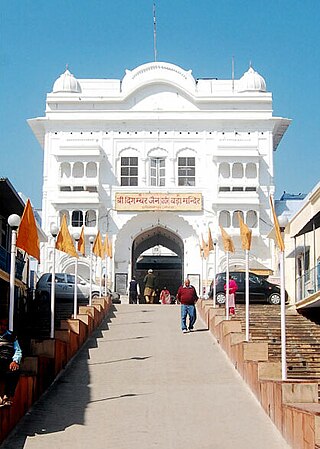
Shri Digamber Jain Prachin Bada Mandir is a Jain temple complex located in Hastinapur, Uttar Pradesh. It is the oldest Jain temple in Hastinapur dedicated to Shri Shantinatha, the 16th Jain Tirthankara.

Shri Nageshwar Parshwanath Tirth or Shri Jain Shwetamber Nageshwar Parshwanath Tirth Pedhi is a Jain Temple situated in Unhel, Jhalawar district, Rajasthan. This temple is dedicated to Parshvanatha, the 23rd Tirthankar.


